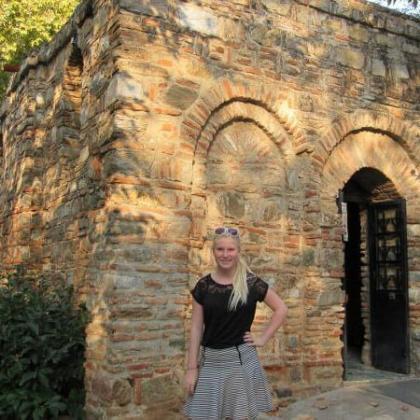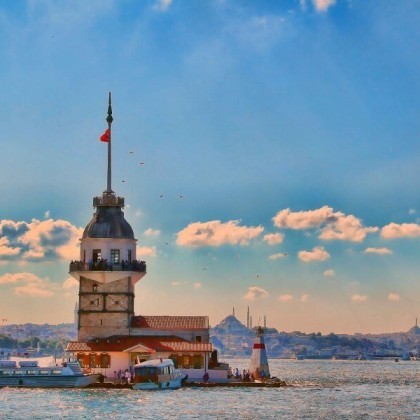Erzurum
Turkey’s highest city, Erzurum sits on an elevated plateau bounded by three mountain ranges. The mountains form the three river valleys that have ensured Erzurum’s strategic importance for millennia, with the Aras winding east from the Palandöken mountains to the Caspian Sea, the Tortum Çay coursing north from the through the Çoruh Valley to the Black Sea, and the Euphrates carving west from the Dumlu Mountains through Central Anatolia. At 1950m elevation, the climate tends toward extremes: winter snowfall is heavy and deep, and summers can be sweltering. Even in the temperate spring and fall, travelers should be prepared for flash hailstorms. When not hailing, however, the sky is clear and bright and the countryside pleasant, making Erzurum an excellent base for daytrips to the southern Georgian churches and the hot springs of Pasinler.
Istanbul New Year’s Eve Party Cruise on the Bosphorus
IstanbulWith this new year's eve party program in Istanbul, you will have an amazing new year party on the Bosphorus. Book it now and don't miss the special price!
View Tour3 Days Ephesus, Pergamon and Pamukkale Tour Package
Ephesus, Pamukkale, PergamonIf you want to make an amazing trip to the Ephesus, Pergamon, and Pamukkale, you should read our tour itinerary.
View TourIstanbul and Cappadocia Tour – 7 Days
Istanbul, Cappadocia, TurkeyIf you want to make a trip to Istanbul and Cappadocia both, we strongly suggest you join this amazing package tour. This tour covers all the accommodations, transportations, lunches...
View TourBest of Turkey Package Tour – 8 Days
Istanbul, Cappadocia, Ephesus, PamukkaleAre you looking for a good traveling package in Turkey? With our 8-days Turkey tour, you will make a trip to every important sight in Turkey. Enquire now for...
View TourEarly 13th-century Arzar-Rum (“Land of the Romans”), as Erzurum was called by the Arabs and the Turks, prospered under the Selçuk Sultans as a center of trade. After the Mongol invasions, Ottoman Sultan Selim I seized the city in 1515. Russia even had its turn, occupying Erzurum in 1829,1878, and again during World War I. In July of 1919, Mustafa Kemal Atatürk chose Erzurum as the site for the Congress of National Delegates in which the principles of the Turkish nationalist movement were established. More recently, Erzurum has become a college town, with a young liberal student population challenging the conservatism of one of Turkey’s most old-fashioned and religious cities.
TRANSPORTATION
The otogar is 3km west of the city center. Most major bus companies provide free shuttles to the town center, and taxis (all have meters) cost approximately $2-3. The main dolmuş lot is a short walk northwest of Gürcü Kapı, but directly heading there means navigating a maze of side streets—it’s easier but longer to go all the wray north on İstasyon Cad. and follow’ the outer loop around.
- Flights: Erzurum’s airport (218 47 98) is a few kilometers out of town on the road to Erzincan, and offers flights to most major cities in Turkey.
- Trains: The train station (218 47 98) is at the northern (downhill) end of the aptly- named istasyon Cad. Erzurum is the penultimate stop on the line from İstanbul to Kars, with intermediate stops in Erzincan, Eskişehir, Sivas, Kayseri, Ankara.
- Buses: Laid out like a miniature international airport, the otogar has 4 cardinal wings: 1 for arrivals, 1 for taxis, and 2 for departures. Not many of the major bus companies operate this far east, and the ones that do, including Ağri (235 20 86), Dadaş (218 27 88), and Ulusoy (234 24 06), have scaled-back service. Shop around; look at the bus you’ll be taking whenever possible.
- Dolmuş: Dolmuş and minibuses leave from the Gölbaş Semt Garajı, 1km northwest of Gürcü Kapı, to destinations as far as Trabzon, Erzincan, and Kars (generally 9am-6pm). Buses are often faster and more comfortable, and not much more expensive.
ORIENTATION AND PRACTICAL INFORMATION
The heart of modem Erzincan is the park at the intersection of Cumhuriyet Cad. and Mederes Cad., which contains the ornate Ottoman Lala Paşa Camii and the elaborate Yakutiye Medrese as well as a collection of çay gardens. Cumhuriyet Cad. runs east to the Kale citadel and the double minarets of the Çifte Minareli Medrese, and west toward the otogar and the airport. Menderes Cad. runs downhill past the Rustem Paşa Kervanseray to reach the Gürcü Kapı (Georgian Gate), the center of the old city. From here, İstasyon Cad. heads down to the train station.
- Tourist Office: (218 56 97; fax 218 54 43), on Cemal Gürsel Cad., near the university, has an excellent city map. The director, Muhammet Yoksuç, speaks English. Open daily 8am-7:30pm.
- Travel Agency: 11 Tours Travel (236 15 15), on Kazim Karabekir Cad., across from the Hotel Polat, organizes local excursions. Little English spoken.
- Iranian Consulate: At the southern end of town on Atatürk Bul. (316 22 85), on the left about 100m uphill from the traffic circle. Expect a wait and some frustration: western travelers need clearance from Tehran, arranged in advance through a travel agency. Mo – Th 8:30am-12:30pm and 1:30-4:30pm; Su 8:30am-12:30pm; hours are erratic.
- Banks: ATMs line Cumhuriyet Cad. The best place to change money is TC Ziraat Bankası on İstasyon Cad. at Gürü Kapı, 50m from Hotel Polat. No commission.
- Hamam: Erzurum’s finest hamams, the combined male and female establishments at Kirkcesme (218 23 41), Ayazpaşa Cad. Kirkcesme Sok. 5., just behind the Rustem Paşa Kervanseray, were closed for renovation at the time of publication. Try Boyahane Hamam, Cennet Çeşme Karşısı Bakırcı M. (233 11 76), just south of the Yakutiye Medrese. Men only. $.50. Open daily 10am-7pm.
- Pharmacies: On Hastaneler Cad. and Cumhuriyet Cad. Open 24hr.
- Hospitals: Numune Hastahanesi is on the well-named Hastaneler Cad. (235 07 51). The university-affiliated Aristirma Hastahanesi, at the southern end of Atatürk Bui. (233 11 22), has several English-speaking physicians. Both are open 24hr.
- Internet Access: The student area along Cumhuriyet Cad. is lined with internet cafes. Most charge $.50-.75 per hr. and are open until midnight. The Café M Lady & Man Internet Center, at 3 Cumhuriyet Cad., 2nd fl., is open daily 8:30am-1am.
- PIT: The main branch lies on Cumhuriyet Cad., 300m west of Menderes Cad. 24hr. inter-national cash phones. No money orders on weekends. Open daily 8am-5:30pm.
ACCOMMODATIONS
In Erzurum, it is worthwhile to avoid the cheapest establishments; for a little extra, you can enjoy the best hotels in town, which have been assigned stars by the Ministry of Tourism. Prices typically include breakfast and bath.
- 12 Kral Otel, 18 Erzincan Kapı (218 77 84; fax 218 69 73), just south of Cumhuriyet Cad. Possibly the most atmospheric hotel in Eastern Anatolia, the Kral is newly renovated to resemble an archeological excavation of Erzurum: pains have been taken to decorate each floor in the style of a different period: Urartian, Selçuk, Mongol, Ottoman, and modern. The suites are filled with amenities the weary traveler will appreciate, such as tiled bathtubs and writing desks. Singles $15, doubles $21, suites $30.
- El Otel Ari, Ayazpaşa Cad. 22 ( 218 31 41). Central and clean, if a bit frayed at the edges. The best value at $5 per person.
- El Hotel Polat, 4 Kazim Karabekir Cad. (218 16 23), behind the TC Ziraat Bank, just south of Gürgü Kapı. Newly renovated and classy, with TV, phone, hot-water bath, and breakfast on the terrace. Singles $12; doubles $18; triples $24. MC/V.
- Otel Oral, 6 Terminal Cad. (218 97 40), is the closest hotel to the otogar. Large lobby with huge leather chairs, and excellent but pricey rooms. Singles $25; doubles $38. Hotel Sefer (218 67 14; fax 212 37 75), diagonally across from Polat at the corner on İstasyon Cad. Similar prices, but not quite as nice. Excellent rooms, though noisy at times. Singles $12; doubles $18; triples $24. MC/V.
FOOD
Erzurum has an excellent agricultural base, and the local cuisine reflects its history as a crossroads between Asia and the Mediterranean. Particularly tasty are the cağ kebap (prepared on a horizontal spit with lots of butter), yaprak sarma (grape leaves stuffed with spicy meat and vegetables), and manti (dumplings served with yogurt and tomato sauce). To satisfy your sweet tooth, visit Erzurum’s , overflowing with local pastries such as kadayıf dolması, made with angel-hair dough, fresh honey, and nuts.
- Erzurum Evleri , one of the most remarkable restaurants in all of eastern Turkey, lies off of Cumhuriyet Cad. in a side alley called Yuzbasi Sok. A carpeted and labyrinthine set of caverns, the Evleri has traditional kilim pillow seating on raised or sunken platforms with fountains and caged parakeets, and has served all varieties of Erzurum specialties since 1928. (233 20 31. Dinners $3-4. Open 9:30am-11:30pm.) El Giizelyurt , 54 Cumhuriyet Cad., also serves up some of Erzurum’s finest grub, with starched tablecloths and great service. (218 15 14. Dinners $34. Open 11:30am-midnight.) It is worth the trip out to try the cağ kebap .
- Dadaş Meşhur Tortum Cağ Kebap Salonu, 26 Kongre Cad. (218 97 26). Sit upstairs by the aquarium but beware: an order of cağ is bottomless, and the skewers will keep coming until you burst.The student population also supports a modest cafe scene on the downhill half of Cumhuriyet Cad. Salon Asya, 27 Cumhuriyet Cad., 50m downhill from Menderes Cad., is a popular kebap and lahmacun spot. (212 12 43. Open 5am-1am.) Donerci Canbaba , No. 18, offers exemplary İskender kebap, with full meals for about $2-3. (234 30 13. Open 7:30pm-midnight.) Have dessert and tea at Kılıçoğlu Sütiş, 13 Cumhuriyet. (Most desserts under $1. Open until midnight.) Night owls wolf down dessert at Serender Palisseria, 32 Cumhuriyet Cad. (218 56 45. Open until 1:30am.) A fruit and vegetable market operates daily northeast of Gürcü Kapı.
SIGHTS
Though they span almost 4000 years of history, most of Erzurum’s major sights can be explored in about five hours. Starting from the eastern side of the down¬town area at the corner of Cumhuriyet Cad. and Tabriz Kapı, you can travel westward (toward the FIT) to the mosque, the castle, museum, and the kervansaray.
- ÇİFTE MİNARELİ MEDRESE. In 1253, Hüdavend Hatun, the daughter of Sultan Alaeddin Keykubad, commissioned this Qur’anic school, the most lauded of Erzurum’s sights. Its twin fluted minarets are tiled in blue and provide the inspiration for the school’s name, “The Twin-Minaret Medrese.” The rooms that flank the entrance portal on the upper and lower levels were once inhabited by students of the religious school. The Ministry of Tourism recently renovated the courtyard, constructing a high-class çay garden where locals and tourists alike find refuge from the summer heat. In back lies the tomb of Hatun. (At the eastern end of Cumhuriyet Cad. Çay garden open 8am-11pm.)
- UÇ KÜMBETLER. The more ornate of these three tombs, just south of the Çifte Minareli Medrese, is claimed to house the body of Emir Saluq, founder of the Saltid state. These three structures date from the early-13th to late-14th centuries and bear a distinctive ornamentation.
- ULU CAMİİ. Built in 1179 by Melik Mehmet, one of the city’s Saltid rulers, this Selçuk mosque has a dramatically different architectural style from the neighboring Çifte Minareli Medrese. Dim lighting, internal columns, and an unusually low create a somber, reverent ambiance. An ingenious dome of layered wooden slats lies before an impressive skylight adorned with muqamas (decorative element on mosque walls). A recent restoration has revitalized prayer traffic, so remove your shoes as you enter.
- KALE. In the 5th century, Emperor Theodosius II built this citadel at the city’s highest point (about 2000m). With each war, the fortress was demolished, and then rebuilt and fortified by the winners. Inside are cannons with Russian and Ottoman inscriptions, a mescit (small mosque) from the 12th century that looks like a kümbet (tomb), and a clock tower. The clock tower provides splendid views of Erzurum and the vast landscape beyond. Bring a flashlight to explore the dark, steep stairway that climbs to the top. (From Ulu Camii, head directly north across the street, and walk upward. Open daily 8am-5:30pm. $.50.)
- OTTOMAN MOSQUES. Continue west on Cumhuriyet Cad. to two Ottoman mosques: the Caferiye Camii (1645), on the right one block before Menderes Cad., and the Lala Mustafa Paşa Camii (1563), at the intersection with Menderes Cad. Lala Mustafa Paşa, the conqueror of Cyprus, commissioned this mosque during his reign over Erzurum. Next door is the Yakutiye Medrese, surrounded by fountains, shade trees, and çay tables. Lion reliefs and ornate geometric designs decorate the school’s west entrance. Today, the medrese contains the city’s best museum. Ethnographic exhibits are displayed in former student rooms. Features include Ottoman arms, ornaments, ceramics, dervish costumes, and manuscripts. (Museum open M-Sa 9am-noon and 1:30-6:15pm. $1.)
- RÜSTEM PAŞA KERVANSARAY. Because Erzurum was such an important inter-continental trading city, Süleyman the Magnificent’s Grand Vizier funded the construction of this kervansaray, which served as a travelers’ rest stop. Today it houses the Rıistem Paşa Bedesteni, a jewelry market with a focus on obsidian, or “black amber,” a black volcanic stone mined 150km away in Oltu. Obsidian is often crafted into tesbih (prayer beads or worry beads). Prices for the beads start at $5.
- ERZURUM MUSEUM. For the intrepid visitor willing to walk uphill along Yenişehir Cad. to reach the museum, a mammoth skeleton and two millennia of coins, pots, and other antiquities await. In the last room, a fractured skull accompanies a starkly one-sided and misleading account of the Turkish-Armenian conflicts (see Armenians, p. 25). (Open Tu-Su 8am-5pm. $1.50; students $1.)
DAYTRIPS FROM ERZURUM
About 25km north on the road to Tor-tum (60km), the road passes Dumlu mountain, the source of the mighty Euphrates. A half-hour dolmuş ride will take you to the village of Güngömuz; cross the brook and the trail starts at the base of the lull to your left, climbing the south face before turning east to climb to the Spring of Euphrates. The hike is not difficult and takes roughly 2[/¿ hours in each direction, with beautiful views of the valley as a reward at the top. Buy local bread, cheese, and produce from farmers in the village.Continuing north, the highway passes Güzel Yayla Pass at 2010m and descends into the Georgian Çoruh Valley (sec The Çoruh Valley), known for its four Georgian Churches. The climate and geological strata change rapidly, with fantastic buttes rising out of The Tortum Çay riverbed. About 26km north of Tortum, a humped bridge on the left signals the road to Bağbaşı, a village 8km off of the highway which houses Ha ho, one of the best-preserved Georgian churches. Bear right after the bridge and follow the main track to Bağbaşı is farther up the road. Haho was built toward the end of the 10th century, and much of the church and monastery owe their good condition to the fact that they have served as the Bağbaşı mosque for several centuries. At the unusual domed gate, a walnut tree presides over a small cemetery; the courtyard is dominated by the 16-sided pointed dome of the spire and the vivid stone carvings of eagles and flying rams that flank the building. Multicolored, glazed enamel tiling is visible on the top of the spire, while the main roof is protected by sheets of aluminum and lower roofs are covered with a thatch of living grass and wildflowers. Behind the main church is the mined Chapel of Mary, which stands over the remains of a tunnel rumored to connect to the other churches in the valley. Enter Ore gallery from the south, and while taking off your shoes to enter tire church, use a flashlight, to examine the allegorical stone carvings that flank the church entrance, still the source of much speculation for the local imam. To the left, a haloed figure with crossed spears stands atop a gryphon and lion. On the right, another haloed figure with a small chinch in his hand rests above Jonas, half-eaten in the whale’s mouth, being nibbled on the head by two large fish. The carving can also be interpreted to represent the bounty of Christ, rescuing man from tire teeth of sin. Inside the church proper, patches of blue fresco in the dome and the apse represent angels and apostles. (Dolmuş to Bağbaşı leave Erzurum (9am, return 1pm.). The church and mosque are free, but a $1 donation is recommended. A few kilometers down the road, several trout farms have campsites and bungalows, as well as fresh fish lunch.)
About 5km north of the bridge to just before the highway crosses the Tortum Çay, a small access road on the right leads to a Genoese Fortress that dominates the valley, dating back to when the Genoese controlled the final portion of the Silk Road from Erzurum to the Black Sea. A trail climbs from the access road to a grassy spot near the fortress. Farther north on the road to Yusufeli is the Georgian cathedral of Öşk Vank in the village of Çamıyamaç and the milky Tortum Gölü, from whose 50m waterfall issues the Çoruh River.
EAST ALONG THE ARAS RIVER:
PASİNLER
A fortress and hot springs tempt travelers to wander about 38km east of Erzurum to Pasinler, where 14th-century Hasan Kale towers over the town. Originally an Armenian structure, the fortress was rebuilt by the Uzun Hasan (1433-1478), ruler of the White Sheep, a Turkmen tribal federation. On arrival, plan a 40min. round-trip hike from the town. Although the views of the four hot-spring hamams on the other side of the highway below arc still impressive, the fortress has been steadily crumbling from neglect and disuse. Sifali Banyölü Otel (661 32 16) offers private-room baths ($3 per hr.) and doubles with mineral bath ($12). The two-star Hotel Kale starts at $3.50 for Roman bath, sauna, and gym. (Private baths $5 per hr. Rooms $7.50 per person.) The pleasant Büyük Kaplica Hamam is a more social option. (Open for women M- Sa 10am-7pm; men M-Sa 7:30-10:30pm, Su all day. Women $.20; men $.50.)
Pasinler has seen better days, and the dusty streets have little to offer the freshly-bathed visitor. The town center is the Şehitler Parki at Cumhuriyet Cad., joined to the highway by Belediye Cacl. Next to the highway, Belediye Cad. con¬tains the Erzurum otogar, the Aymer Hypermarket, Sanko Bilardo Internet Cafe, and the best restaurants: Hajibaba Lok., Saray Lok. (661 47 00), and Ozlem Lok. (661 34 84), serving standard fare for $1-3. (Pasinler Beledesi (661 35 01) shuttles between Erzurum and Pasinler (every 45min.). It loops through town and can be hailed at the bus stop on İstasyon Cad., opposite Hotel Sefer, or from 500m south of Cumhuriyet Cad.)
TERCAN
Tercan is the ideal place to break the 1/2 hr. journey between Erzurum and Erzincan. Across the road from the gas station, Kervanseray Cad. winds uphill to the splendid Mama Hatun Türbesi, built in 1182, which holds the remains of Mama Hatun, a Selçuk princess who helped Saladin conquer this portion of Anatolia. In each of the eight half-circles that form the structure’s outer walls, a lesser member of the nobility is buried. At the center is a mihrab atop a vaulted tomb. If it is open, head through the door and down the steps to see the sarcophagus, covered in green felt. Above it, the prayer room is still used by pilgrims and pious Muslims, especially women. A winding staircase in the wall across from the türbesi leads to the roof and a majestic view of the valley. The ruins of an inn and the kervanseray complete the complex. On the way back down, grab a picnic lunch from the fresh produce bazaar in front of the kervanseray, or stop at the Kardeşler Lokantası , 76 Kervanseray Cad., which is crowded with locals and offers a broad menu, including a delicious visaka. (441 36 85. Full meal $1-3. Open until 10pm.) If the climb to the türbesi has you feeling grimy, the local hamam is right next to the kervanseray. (746 4413. Open 4pm-midnight, women only Sat.) There is no reason to stay in Tercan overnight; for those stranded, however, the Kervanseray Otel, diagonal across the highway from the gas station in the Belediye building, offers rooms with bath and hot water, ( 441 25 88. Singles $5; doubles $10.) (Buses between Erzurum and Erzincan are frequent Both $2.)
PALANDÖKEN
Palandöken, 10km from Erzurum, is home to some of Erzurum’s best ski slopes. The ski season runs from late December to March, but serious skiers can arrange to ski the upper slopes as late as June. In winter, frequent transportation connections are available, but during the summer you’ll have to either call a resort to send a car, or pay for a taxi ($19 round-trip). The Dedeman Hotel ( 316 24 14), right on the slopes, has a four-star rating and a price to match.





